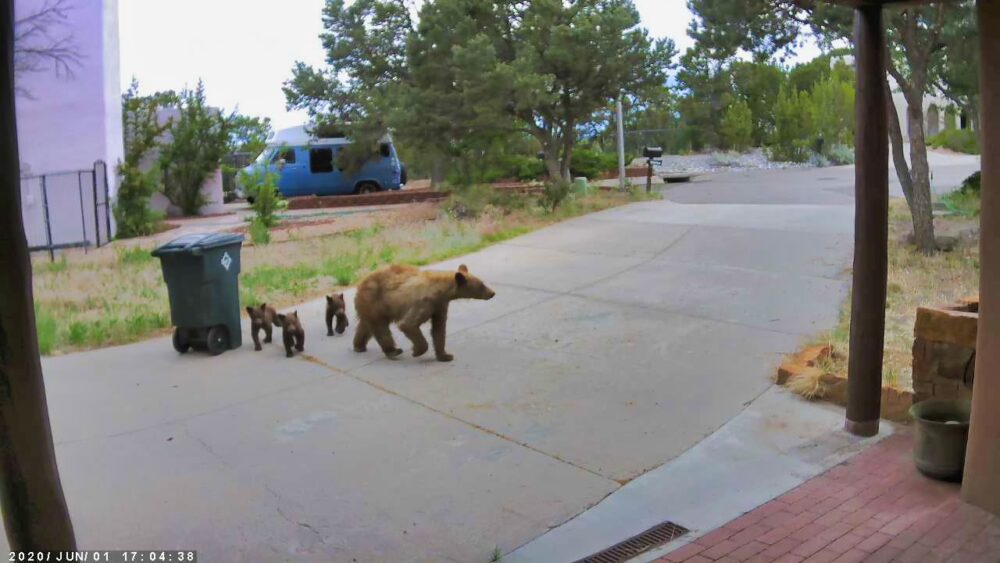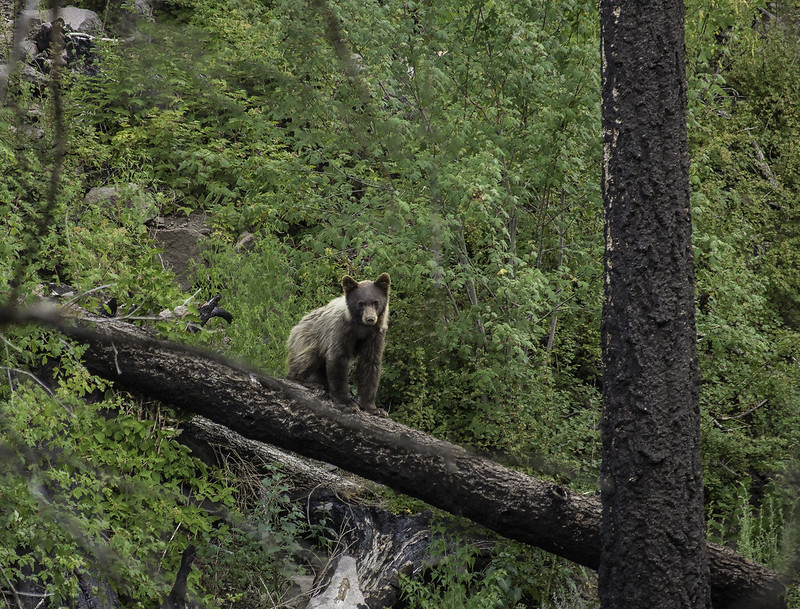
UPDATED: September 2, 2020
By Jenna Stanek
Los Alamos County is home to a unique subspecies of black bear, the New Mexico black bear (Ursus americanus amblyceps). The New Mexico black bear is the official state animal of New Mexico and occurs in Colorado, New Mexico, western Texas, eastern Arizona, and southeastern Utah. Grizzly bears, also called brown bears, no longer occur in New Mexico. The color of the black bear can vary from black, brown, to cinnamon. Cinnamon colored black bears are the most common color we see in New Mexico.
Black bears are opportunistic omnivores and have a diet that varies according to the seasonal availability of foods. In the spring, their diet is mostly grasses, forbs, roots, mushrooms, insects, and carrion. In summer, they forage on grasses, forbs, acorns, insects, berries, and other fruit. Later in the summer and in the fall, bears eat acorns, piñon nuts, and juniper berries.

A black bear’s potential life span may exceed more than 30 years. In New Mexico, wild bears have been documented to live 20 – 25 years. The black bear does not start to breed until they are 5 – 6 years old and a female who successfully raises cubs will mate only once every two years. Two of their most frequent causes of death are predation by other bears and becoming a nuisance by getting used to accessible human garbage and subsequently having to be killed.
During a drought or when food is scarce, bears often extend their range looking for food. Their keen sense of smell can lead them to accessible human garbage. Worse yet, a mama bear that has cubs will teach them her bad habits. The most effective solution to deter a bear is to bring in or make inaccessible any potential food sources. If the bear wanders into neighborhoods and does not find food available, it will move on.
Relocation of nuisance bears occurs after repeated complaints. The bear is ear tagged and relocated. If the bear continues to be a nuisance or is considered to be dangerous to humans, it is killed. An inaccurate public perception is that relocating problem bears means a happily ever after for everyone involved. However, most transplant bears don’t have much of a chance for survival, with only a 30 – 35% success rate for adult bears. If a nuisance bear is moved into another bear’s territory the resident bears will chase them away or kill them. Young cubs moved with their mama bear may also share this fate. Additionally, a relocated bear will travel vast distances to find its way “home” or will continue their bad habits in their new location.
Female black bears remain near their birth site throughout their life so juvenile females are likely to try harder to return to the capture area than young adult males (<4 years old). Whether a bear is moved or not, human food availability at the original location still needs to be addressed. Relocation merely treats the symptoms, not the initial problem of bears accessing human food. New bears will fill the empty territory left by the relocated bears and a new cycle of bears utilizing human foods and subsequent conflict will begin.
We can all do our best to minimize human-bear interactions by remembering these six bear-wise basics. Please stay bear aware!
Help keep wildlife wild by remembering these bear-wise basics:
- Never feed or approach bears. Feeding bears — intentionally or unintentionally — trains them to approach buildings and people to find food. It is illegal to create a nuisance bear by feeding them.
- Secure your food and garbage. Food and food odors attract bears, so don’t reward them with easily accessible garbage or food (including pet food left outside).
- Unsecured garbage is the primary cause of most human bear conflicts. Bears generally avoid humans unless they become conditioned to eating human food or garbage.
- Remove bird feeders when bears are active. Take in your feeders at night or if bears have recently been seen near your home. Alternatively, only put feeders out during the winter when bears are hibernating.
- Clean and store grills. Make sure that all grease, fat, and food particles are removed after grilling. We recommend storing your grill in a secure garage or shed when it’s not in use.
- Don’t put trash out until the morning of your collection. Store your garbage can in your garage and be sure to properly use a bear resistant trashcan from Los Alamos County if you have one. The County is currently out of these roll-carts. While they are acquiring more, we encourage people to use ratchet straps, team up with a neighbor that has a bear-resistant cart or garage, use electric fencing, or otherwise get creative in finding ways to secure their trash from bears. Get some ideas in this letter from County Councilor James Robinson.
Do you want to learn more?
There are many great resources out there that can help you learn more about staying safe around black bears. Here are a few of our favorites!
- This booklet from the New Mexico Department of Game & Fish explores the history of bears in New Mexico, explains why relocating bears is difficult, and gives some tips on keeping yourself and our bear population safe. Their brochure on black bears also provides some useful advice.
- Sandia Mountain Bear Watch has some useful tips on their website about living in bear country.
- BearWise is an organization located in the Southeast, but they provide some great advice on black bear safety and best practices at home.
- Daryl Ratajczak, Wildlife Biologist and Wildlife for You Instructor, explored the amazing ways that black bears hibernate in a blog post for PEEC.
- Learn more about our local black bears in this fact sheet from Bandelier National Monument.

So glad this is out. Some people put their garbage out at night and this results in trash all over street in morning